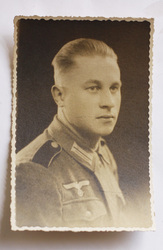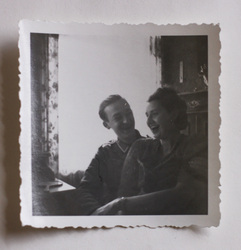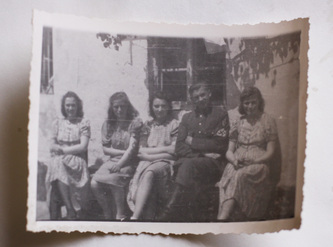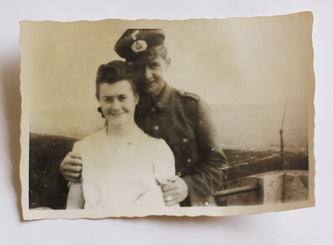 Today's posting is a delacate topic: photographs of Nazi Germany. What are we to do with images of German soldiers? There are various restrictions and laws around the world prohibiting the sales of Nazi memorabilia. (You can see eBay's here.) In spite of the difficult subject matter and horrific legacy of Nazi's upon the world, I feel it is important to consider the images for a number of reasons...and pehaps ones that may seem contradictory. First, we live in a strange time of Holocaust denial. What makes this strange phenomena worse, is that it is growing. Because of photography's veracity, these images and other like them, serve as a reminder of the horrible attrocities the Nazi's committed. These images do so only indirectly, however. Secondly, I noted in my post on the 13th that "photography is intimately caught up with the documentation of place and time, sometimes the poignancy of history, like Barthes prick of the punctum, is startling." One of the other peculiarities about looking at vernacular photographs is that as viewers we are peering into another person's life. And in these cases, they are not able to interpret the image for us. We are outsiders to the photographic event. Many of the photographs I've posted here came in one large lot bought off of eBay. What was striking to me in these photographs, like Barthes punctum, was the domestic nature of in which many of the photographs shot...homes, weddings, with friends and lovers laughing and eating. One of the reasons the photos are important to see is that they humanize those who are often painted in the widest of brush strokes as Nazi's. For me, the prick of these images highlighted the nature of being an American, brought up with Hollywood films full of patriotic American soldiers fighting the Nazi's. And not to deminish the atrocities of the Nazi's nor the sacrifices of Allied troops, but the images remind us of the humanity behind the stereotypes cast about in popular culture. It reminds me of the dangerous power of propaganda within the popular imagination. Of the thousands of photographs that I have, several hundred are of American soldiers. Photographs of them with girlfriend or wife. Photographs of them with parents and siblings. Photographs of them with their children and friends. Photographs of them in their uniforms getting married, going for dinner, relaxing in the safety of their home. The difference between these images is simply the uniform which subsequently triggers all of our collective memory and preconceptions into action. Historically, "stereotypes" originated from an efficient printing process that allowed for repeated usage of one typesetting. We use the term now in a metaphorical manner. “Stereotypes are rather negatively defined as ‘conventional, formulaic and oversimplified conceptions, opinions, or images’ that may communicate without nuance or subtlety. For visual communicators, whether they are filmmakers, photographers, graphic artists, etc…stereotypes are useful devices because they are easily understood and make clear, albeit possibly injurious, points.”[1] “Stereotype is a shorthand way to describe a person with collective, rather than unique characteristics. To stereotype is, in both a real and metaphorical sense, to lose sight of the individual.”[2] And while I absolutely condemn the atrocities committed by the Nazi's, these photographs of the intimate moments of life of these German soldiers remind me to consider the humanity of the individual as well as the larger historical and geopolitical context of their life. [1] Images that Injure, Lester & Dente Ross, xi. [2] Lester & Dente Ross, 2.
0 Comments
Your comment will be posted after it is approved.
Leave a Reply. |
Ryan StanderArchives
January 2018
Categories
All
|










 RSS Feed
RSS Feed
